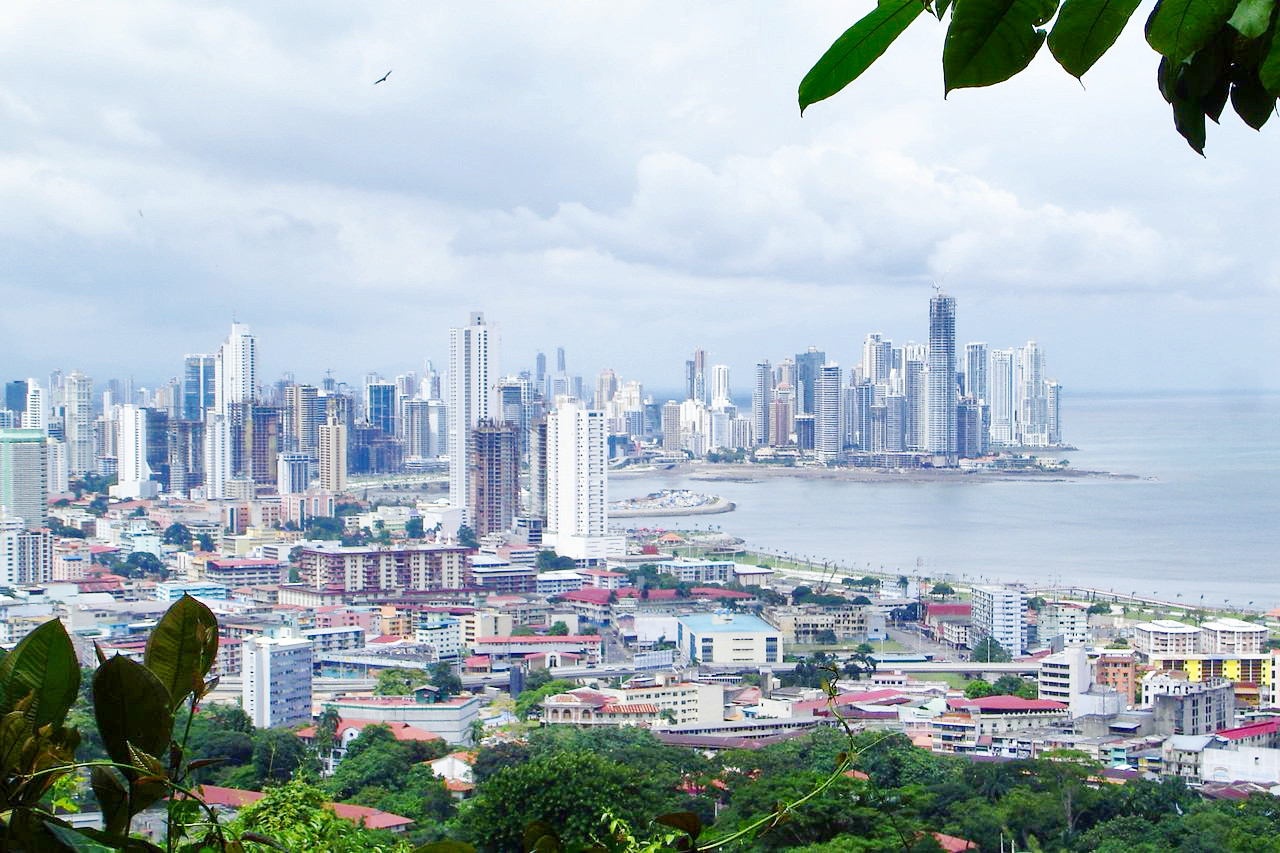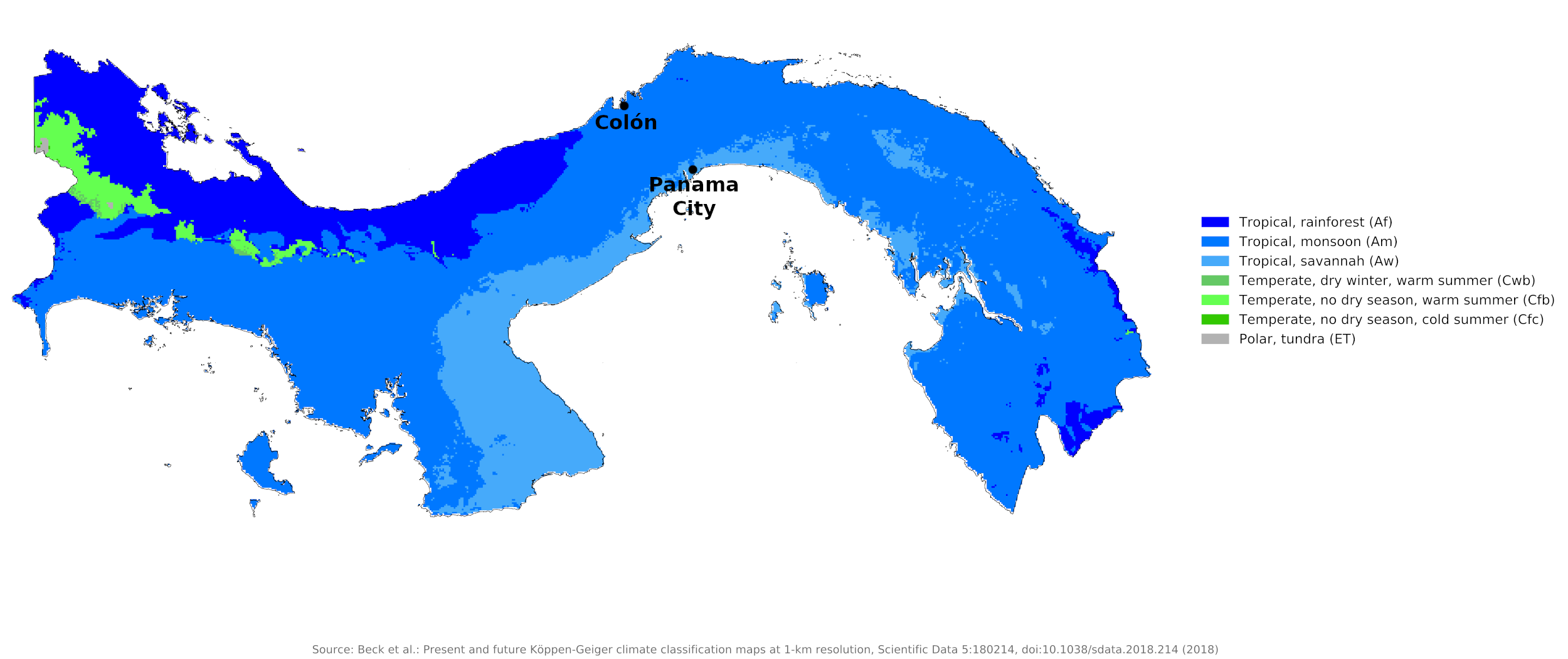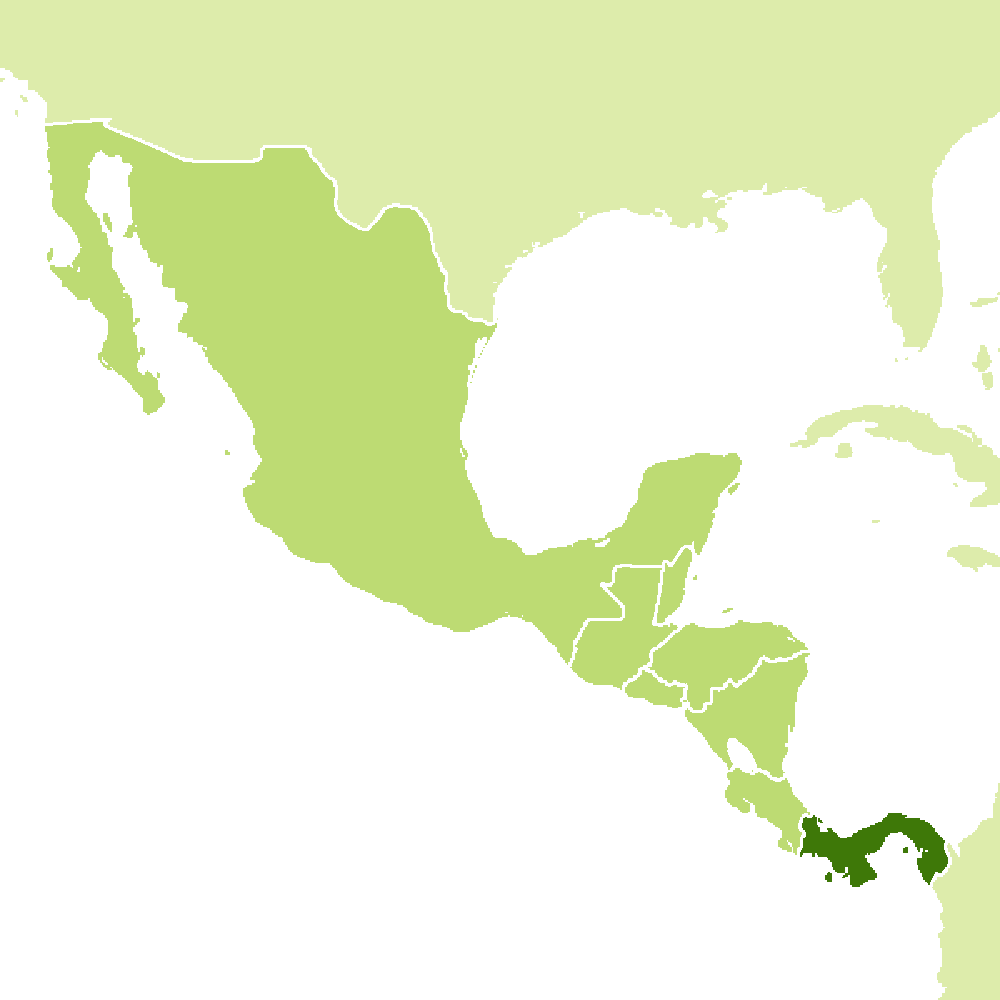The Climate of
Panama
 Skyline of Panama City
Skyline of Panama City
Climate Map
 Climate map of Panama
Climate map of Panama
What is the climate of Panama like?
Panama occupies the narrowest part of the Central American isthmus, a narrow strip of land that connects Costa Rica and Colombia. It lies between 7° and 9°N and owes its existence as an independent state to the cutting of the Panama Canal by the United States; previously it was part of Colombia. The country lies between the Caribbean Sea and the Pacific Ocean.
Panama has a tropical climate with temperate areas at the higher elevations of 700 to 1,500 meters (2,300–5,000 feet). There is little seasonal change in temperature. There are two seasons: a rainy "winter" from May through December, when humidity is 90 percent to 100 percent, and a drier "summer" from January through April, when the northeast trade winds arrive. Panama's average temperature is 29°C (84°F) on the coasts; Here temperatures are uniformly high, as is the relative humidity. The highlands are markedly cooler, and frosts occur in the Cordillera de Talamanca in western Panama.
Daily variation in temperature is low; on a typical dry-season day in the capital city, the early morning minimum may be 25°C (77°F) and the afternoon maximum 30°C (86°F). The temperature seldom exceeds 33°C (91°F) for more than a short time. Breezes tend to rise after dusk in most parts of the country.
Panama has distinct rainy and dry seasons. Almost all of the rain falls during the rainy season, which typically lasts from May to December but lasts between seven and nine months. The precipitation cycle is primarily driven by two factors: moisture from the Caribbean, carried by the north and northeast winds that prevail most of the year, and the central mountains, which act as a rain shelter for the Pacific lowlands. A third influence present in late autumn is the southwest wind off the Pacific. This wind brings some rainfall to the Pacific lowlands, modified by the highlands of the Peninsula de Azuero which provides partial rain protection for much of central Panama.
Rainfall patterns are different on Panama's Caribbean and Pacific coast regions. In general, it rains much more heavily on the Caribbean than on the Pacific side of the country. The Caribbean coast and mountain slopes get rain throughout the year, receiving from 1,500 to 3,600 millimeters (59 to 140 inches) annually. The Pacific coast experiences a more distinct dry season and has annual rainfall of 1,100 to 2,300 millimeters (45 to 90 inches).
From year to year, Panama has considerable variation in the amount of rainfall, since the country is affected by El Niño and La Niña weather patterns. Although rain-season thunderstorms are common, the country is not in the path of Caribbean hurricanes.
The climate of Panama City is representative of the Pacific coast, that of Colón is representative of the Caribbean coast.
| Climate data for Panama City (1971–2000) | |||||||||||||
|---|---|---|---|---|---|---|---|---|---|---|---|---|---|
| Month | Jan | Feb | Mar | Apr | May | Jun | Jul | Aug | Sep | Oct | Nov | Dec | Year |
| Average high °C (°F) | 31.7 (89.1) | 31.7 (89.1) | 32.2 (90.0) | 32.2 (90.0) | 31.1 (88.0) | 30.6 (87.1) | 30.6 (87.1) | 30.6 (87.1) | 30.0 (86.0) | 29.4 (84.9) | 30.0 (86.0) | 30.6 (87.1) | 31.0 (87.8) |
| Daily mean °C (°F) | 28.1 (82.6) | 28.1 (82.6) | 28.6 (83.5) | 28.9 (84.0) | 28.3 (82.9) | 27.8 (82.0) | 27.8 (82.0) | 27.8 (82.0) | 27.2 (81.0) | 27.0 (80.6) | 27.2 (81.0) | 27.5 (81.5) | 28.1 (82.6) |
| Average low °C (°F) | 24.4 (75.9) | 24.4 (75.9) | 25.0 (77.0) | 25.6 (78.1) | 25.6 (78.1) | 25.0 (77.0) | 25.0 (77.0) | 25.0 (77.0) | 24.4 (75.9) | 24.4 (75.9) | 24.4 (75.9) | 24.4 (75.9) | 24.8 (76.6) |
| Average precipitation mm (inches) | 29.3 (1.15) | 10.1 (0.40) | 13.1 (0.52) | 64.7 (2.55) | 225.1 (8.86) | 235.0 (9.25) | 168.5 (6.63) | 219.9 (8.66) | 253.9 (10.00) | 330.7 (13.02) | 252.3 (9.93) | 104.6 (4.12) | 1,907.2 (75.09) |
| Source: World Meteorological Organization | |||||||||||||
| Climate data for Colón | |||||||||||||
|---|---|---|---|---|---|---|---|---|---|---|---|---|---|
| Month | Jan | Feb | Mar | Apr | May | Jun | Jul | Aug | Sep | Oct | Nov | Dec | Year |
| Average high °C (°F) | 29 (84) | 29 (84) | 29 (85) | 30 (86) | 31 (87) | 30 (86) | 29 (85) | 29 (85) | 31 (87) | 30 (86) | 29 (84) | 29 (84) | 29 (85) |
| Daily mean °C (°F) | 26.5 (79.7) | 26.5 (79.7) | 26.5 (79.7) | 27.5 (81.5) | 27.5 (81.5) | 27.0 (80.6) | 26.5 (79.7) | 26.5 (79.7) | 27.5 (81.5) | 26.5 (79.7) | 26.0 (78.8) | 26.5 (79.7) | 26.8 (80.2) |
| Average low °C (°F) | 24 (76) | 24 (76) | 24 (76) | 25 (77) | 24 (76) | 24 (75) | 24 (75) | 24 (75) | 24 (75) | 23 (74) | 23 (74) | 24 (75) | 24 (75) |
| Average precipitation mm (inches) | 110 (4.3) | 51 (2.0) | 36 (1.4) | 94 (3.7) | 270 (10.8) | 370 (14.5) | 420 (16.5) | 420 (16.4) | 290 (11.5) | 470 (18.4) | 620 (24.4) | 320 (12.6) | 3,471 (136.5) |
| Source: Weatherbase.com | |||||||||||||
References
- E. A. Pearce, Charles Gordon Smith, (1990) The Hutchinson World Weather Guide, John Murray Press. ISBN 1859863426
- Timothy L. Gall, (ed.), (2003), Worldmark Encyclopedia of the Nations, Eleventh Edition, Thomson Gale
- Federal Research Division, Library of Congress, (1989), Panama: a country study. Claitor's Pub. Division.
- Hugh Chisholm, (ed.), (1911), Encyclopædia Britannica, Eleventh edition, Cambridge University Press
The Climate of
Panama

In summary:
Panama is tropical, but temperatures vary according to location and altitude. The annual average temperature on both coasts is 29°C (84°F), and it ranges from 10° to 19°C (50 to 66°F) at various mountain elevations. There is little seasonal change in temperature.
Rainfall averages 1800 mm (70 in) in Panama City and 3300 mm (129 in) in Colón. The period of lightest rainfall is from January to March.